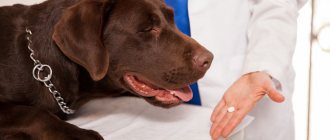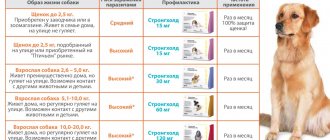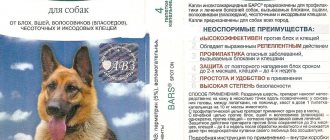Stress or resentment
It does not immediately threaten the dog, except that it brings discomfort to the owner. However, a grudge that lingers or persists may indicate a state of stress.
If you observe the following symptoms, the dog is not offended, but is suffering from stress:
- Flatten ears and tucked tail.
- Rapid breathing.
- Nervous yawning and muzzle licking.
- Tremor.
- Attempts to curl up into a ball or hide.
- Aggression, with obsessive attention from people or other animals.
This is interesting! Science has proven that the feelings of dogs and people are similar, but not identical. That is, a dog’s resentment can indicate not only a “sediment,” but also fear, uncertainty, envy, jealousy, etc.
To understand exactly what your dog feels and how long he can be offended, you need to “look” into the world of canine psychology. After all, the opinions of owners and scientists on this matter are completely opposite.
Associative memory
Dogs do not have long-term memory like humans, who are able to remember certain events over a long period of time and use them to make decisions. However, dogs do have associative memory. This means that their brain latch onto circumstances or images that they can then use to assimilate a similar situation in the future.
For example, if you ever get sick and are picked up by an ambulance, your dog will remember that moment. However, if you hear an ambulance siren, you will associate the sound with negative feelings. You may not know why, but you will know that the mermaid gives you a negative feeling.
On the other hand, if someone was very kind to your dog and gave you a lot of love and attention, you will remember that feeling when you see and smell that person again...
What type of memory do dogs use?
Instead of episodic long-term memory, associative memory predominates in dogs. People also have this type of memory. For example, when you remember a person after smelling his perfume somewhere, this is an associative memory.
Associative memory in dogs can be divided into three types:
- Positive. A feeling of security, tenderness towards the owner, receiving encouragement. Learning and training are built on the positive type of memory.
- Negative. Events associated with visits to the veterinary clinic, fights with relatives, fears, punishments.
- Neutral. Doesn't affect life experience in any way, but can influence the dog's behavior. An example is the trick a dog uses to get a treat by making a neutral experience positive.
Genetic and short-term memory
The genetic memory of dogs is responsible for images and patterns of natural behavior of an innate nature. In parallel with genetic memory, dogs develop specific memory , which is improved on the basis of individual experience, that is, in the process of learning the animal, it regulates the social aspect of behavior.
The degree of development of these two types of memorization depends on their level of evolutionary development.
Animal psychologists believe that dogs have short-term memory, and memories are retained no longer than a few minutes, and most often no more than 10-20 seconds, so this type of memory is unlikely to contribute to the animal’s strong learning.
What is dog insult
The behavior that causes many owners to assume that their dog is “holding a grudge” is most likely caused by negative associations that have nothing to do with the current period of time. The dog does not remember specific events that upset him, he is simply in a bad mood because he succumbed to the memories.
This is interesting! Dogs do not remember the reasons why they were once offended, but this does not make negative emotions any less powerful.
Animal behaviorists have conducted separate studies of canine resentment and also come to the conclusion that this emotion should rather be called indignation or “the blues.” But what about the dog’s reaction to specific actions?
How do you explain a dog's attempts to hide if the owner takes out nail clippers? Most likely, the negative reaction is not associated with the procedure itself, but with a negative experience - the dog once experienced pain during nail trimming and avoids repeating the situation. This is a life experience that is not associated with resentment.
Regular fights with the same dog or dogs of certain breeds can be explained similarly. Your pet has negative experiences involving danger, stress, and pain. He attacks first because he does not expect mercy from nature.
In 2017, an interesting experiment was conducted, which gave rise to fundamental doubts in the interpretation of dog grievances. The essence of the experiment is that the dog owner needed help from another person (asked for help opening a box), but he was refused in front of the dog. The offended owner was indignant, cried, screamed, kicked the box, and the dog watched. Afterwards, the person who refused to help the owner offered a treat to the dog and it refused. The results of the study showed that within the framework of short-term memory, dogs are able to take offense “for” the owner.
Main types
Memory in dogs has two main types: genetic and lifetime.
Genetic
It determines behavioral patterns formed by previous generations, imprinted in the genotype, and transmitted by inheritance. The genetic memory of every dog is much more developed than that of a human. It is this that determines the dog’s predisposition to a pack lifestyle. She considers everyone who makes up her habitat - people and animals - to be members of her pack. She finds her place in this hierarchical ladder and chooses a leader to whom she obeys.
Lifetime
Lifetime memory is associated with gaining diverse experiences throughout life. It regulates the social aspect of the animal's behavior.
It is believed that the dog has developed the following types of lifetime memory:
- long-term;
- short-term;
- associative;
- episodic.
Knowing the importance of each species for the adaptation of an animal in the surrounding world, we can better understand the motives of our pet’s behavior in a given situation.
Long-term
Long-term memory plays a very important role for an animal, as it is associated with aspects of life that help in survival and evolutionary development. It is this type of memory that is involved in the creation and development of relationships with a person, on whom the pet’s prosperous existence and continuation of the family depend. Long-term memory includes sensory memory (visual, olfactory and auditory), which is much better developed in dogs than in humans, since they have very good olfactory and auditory abilities. Animals receive basic information about the world around them using nasal receptors. It is this canine quality that is very valuable for humans. An animal can simultaneously remember several thousand odors. Once a dog finds itself in a certain area after a long break, it can navigate by a familiar smell, even if it walks among many strangers.
The dog also boasts auditory memory. Thanks to the ability to perceive a very wide range of sounds, she can navigate through them. From afar, a dog can recognize the steps of its owners who are coming to him after a long separation.
At the same time, the animal’s visual memory is not very good, and accordingly, it remembers visual images poorly. We can say that our pets see with their nose and ears.
Short term
A dog has very little short-term memory. She remembers the event that just happened for a few minutes at best. This type of memory has no significant value, since it does not contribute to the acquisition of useful experience, and therefore does not contribute to survival.
Associative
Associative memory significantly prevails over real or short-term memory. Associations are very important to her. They are imprinted for a long time in order to determine her behavior in a given situation after a significant period of time. Since the animal lacks logical thinking, it is replaced by so-called associative chains. For such a chain to occur, an external push is needed. Then, in a similar situation, the pet will always behave in a certain way. There are, for example, the following associative chains: “leash - walk”, “bowl - food”, “following a command - reward”.
The dog's learning process uses associative memory. It is the basis for the development of conditioned reflexes, on which the training process is based. Using a set of specially developed techniques, the animal gradually develops certain skills. The presence of these skills makes the coexistence of a dog and a person useful and enjoyable.
Associations are especially strong if they relate to unpleasant situations. It doesn’t matter how much time has passed, but the negative association chain “veterinary clinic - pain” is almost impossible to change.
These associations cannot be called memories of the past. For a dog, there is only present time. She lives “here and now.” This is why punishing a dog for an event that happened some time ago is useless. The dog will not understand why he was punished. He simply will not be able to create the necessary associative chain, because short-term memory is short-lived.
Episodic and declarative
The presence of episodic memory in dogs has not been fully proven. Scientists suggest that she can remember events that happened some time ago. No one can say this for sure yet. There are certain difficulties in studying this ability of animals.
Hungarian animal psychologists also suggested that the dog has the rudiments of declarative memory. This means that it can reproduce some human actions after a fairly significant period of time. But it is also impossible to say this for sure. If in humans this type of ability to remember is based on episodic and semantic (storing a system of generalized knowledge about the world) memory, then the presence of these types in dogs has not been proven.
Comparing it with a person’s memory, we can say that a dog’s memory is more primitive. But, thanks to natural selection, its individual species (mainly those on which the animal’s ability to survive and procreate depend) are better developed, so much so that the dog is a worthy partner for humans in many areas of human existence.
Dog's grudge against owner
Long-term study of the “mechanisms” of dog feelings has not given a clear answer to the question of whether dogs are capable of being offended or holding a grudge against their owner. Doubts arise against the background of the high sociality and insight of four-legged animals.
Example: you accidentally step on your pet's paw, he squeals and runs away. The dog is in pain, but he understands that your action was not intentional. Without further development, the pet will forget about the incident in 2-10 minutes. But you feel shame and guilt, run after your pet and begin to feel sorry for it.
The pet understands that you are upset, but does not understand the reasons for the emotions. Being an empath, the dog becomes upset and appears hurt. What is the conclusion? If the dog tries to leave or hide, there is no need to chase it. Thus, the pet is trying to avoid your negative emotions, and not show his own.
Forced departure
The owners of a two-year-old golden retriever found themselves in this situation. With tears in her eyes, the woman expressed fear that Taffy might forget her owners if she didn't see them for two years. But they were so close!
The couple received diplomas of education, completing studies in the field of psychology. But it was impossible to get a decent job in Vancouver then. They could only work as substitute teachers, which made their family budget extremely limited.
But soon they received an offer to work in China, where they could teach English under a special program. In addition to the good salary, the provision of free housing was also attractive. This was a great opportunity to accumulate some savings that would be enough for a down payment on a house or apartment.
Vacationing in Russia has become even more profitable: how a tourist can get cashback
A step-by-step recipe for making cute cakes with an original design and taste
We make a comfortable duvet cover with our own hands: you will need two sheets
The only thing that darkened these rosy prospects was separation from my beloved pet for almost two years. The owner was afraid of losing contact with the dog, who could forget them and lose their former affection. The woman expressed the fears that tormented her to her psychology teacher.
How long does a dog remember its previous owner?
The findings support the hypothesis that animals can remember their previous owners, but exactly how they remember them is still unknown. For example, a dog that has lived in difficult conditions may associate negative emotions or anxious behavior with certain objects or places.
But it is known for certain that dogs miss their owners when they leave, and are incredibly happy when they return home.
However, this does not mean that the pet yearns for another family. If you surround your dog with an atmosphere of love and care, he will be happy to live in the moment and enjoy being in his new forever home.
Human reaction
These changes usually cause great concern for the dog owner because your pet is no longer the same. he no longer goes for stroking the way he used to and doesn’t play anymore like he used to.
With some extra care, however, the animal can lead to a comfortable life.
.— 86— > the veterinarian prescribes the necessary medications needed by the animal to combat diseases associated with memory loss.
However, you should keep in mind what this lack of treatment for cognitive dysfunction syndrome provides.
How to train animals so they remember quickly
There are 3 basic rules for training animals.
If dogs are easy to train, then with cats everything is much worse. The owner, who still wants to teach her something, must have a good understanding of the characteristics of the cat's memory. For a furry animal, only extremely necessary information is valuable. The cat does not remember the appearance and smells of people who did not show any attention to him, but for years he will keep in his head the image of someone who once hurt him.
Therefore, an animal’s training needs to be reinforced with things that are meaningful to it: food, affection, praise. For the rest of their lives, cats remember the sound of the refrigerator door opening or the rustling of a pack of dry food. Scientists have found that cats have powerful short-term memory. In dogs, the opposite is true: the long-term one is better developed, and the short-term one does not exceed 5 minutes (in cats it works on average 12 hours).
Complexity of research
Unfortunately, scientists have not conducted any experiments in this area. The complexity of the research lies in the labor-intensive nature of the process, which is difficult to accomplish from a practical point of view. While it is possible to separate dogs from the same litter, puppies and mothers, and test their bond after a few years, it is not possible to separate dogs from their owners for entire years to test the remaining bond. Except in cases where such separation is a necessary measure due to current life circumstances.
Of their own free will, no one wants to part with their dog for a long time, just to help scientists in their experiments. In addition, such experiments cannot be considered full-fledged when a person lived with a dog only for a while, and then they were separated. This will be a completely different relationship than the long-term relationship between the owner and the pet, who have lived together for more than one year. The age of the animal also plays a role, but more on that a little later.
Alexandra Shoua's eldest daughter grew up without him, but forgave him all his insults
Water scarcity on Earth is increasing: March 22 is World Water Day
One of the most beautiful nations: photos of Ossetians from which you can’t take your eyes off
History of Flannel
70-year-old Stephen told his dog’s story to a psychologist. His black dog was named Flannel because of the resemblance of his ears to this light, soft fabric. The dog's owner had to join the army at the beginning of World War II. When Stephen went to war, Flannel was three years old, and when he returned, the dog was already ten years old.
In Russia they are asking to cancel the mandatory fee for choosing a seat on an airplane
Coincidentally or not: why Lady Di put a necklace on her head, which upset the queen
They Can't Chew: Things That Are Very Difficult for Cats to Do
Before Stephen left for the army, he and Flannel were very close. The puppy was his first dog, so they spent a lot of time together and were true friends. Every time before a walk, Flannel danced in front of his owner, spinning, jumping and raising his voice, making “woo-woo”. The dog performed such a dance only in front of him, thus showing his affection and love. Stephen thought more than once to come up with something similar for himself, to show the dog his love in a special way.
The last time he saw the dog was in 1941, after which he went into the army. Stephen was then sent to North Africa, then to Italy. After the end of the war, people began to be sent home. However, Stephen had to stay longer due to the liberation of the prisoner of war camp. It was only in 1948 that he was finally able to return home.











